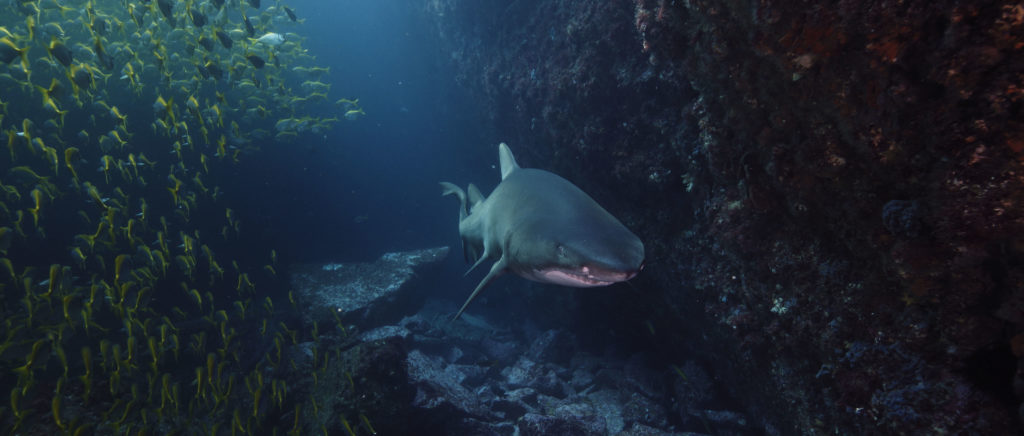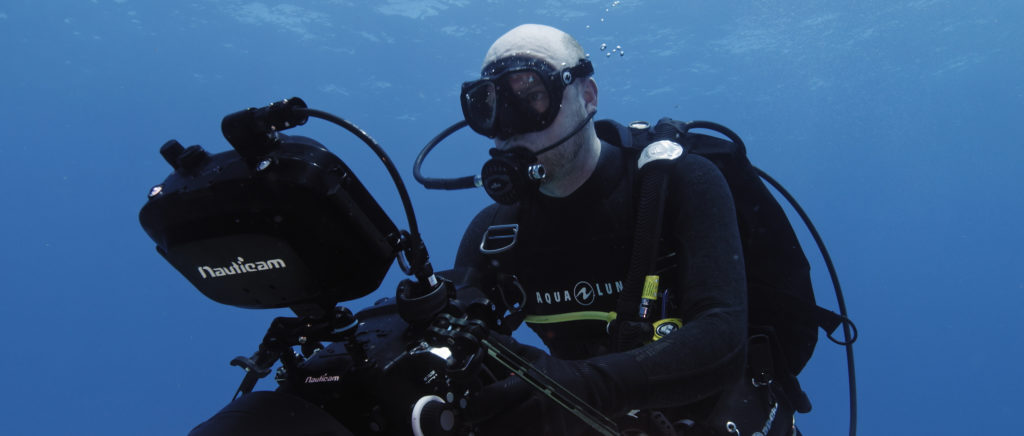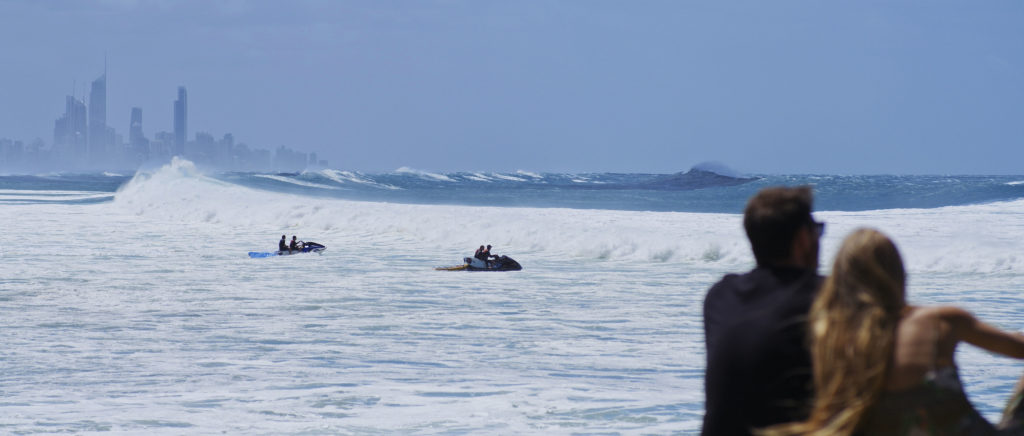January 28, 2020
10 min read
As a professional underwater cinematographer, the best part of my job is the opportunity to visit exotic, far-flung locations doing what I most enjoy doing most, and that is filming sharks in the wild.
Having been fortunate enough to travel around the world and enjoying some of the best diving the oceans have to offer, one destination has always eluded me. The one destination which has been a dream of mine for over thirty years, and that is Australia.
At the Wildscreen Film Festival in Bristol, UK, I discussed with Panasonic the potential for shooting a commercial for the Panasonic AU-EVA1 to highlight just how good the camera is for both broadcast and commercial use in underwater environments. There were two main reasons for this. Firstly, logistics and opportunity had aligned in a way that would make the cost of a production of this type much less limiting than it would normally be, but more importantly, to let other “mid-weight” underwater cinematographers know that, without realizing it themselves, Panasonic had found a solution for a prolonged and irritating problem.
Underwater cinematography is an expensive business to get into. For all cinematographers and camera operators out there working on terrestrial projects (which I also do), you'll know how the cost of kit soon stacks up and can quickly spiral out of control. For the underwater operators out there, we also have to factor in housings, lighting, training, and not forgetting both dive gear and commercial qualifications.

Underwater cinematographer David Diley capturing ProRes RAW footage with the AU-EVA1 and Atomos Shogun Inferno recorder - both in Nauticam housings.
When new cameras are announced, if the specs and first released images fit the bill for underwater use, we have to wait and see if one of the main housing manufacturers will release a housing for our next upgrade. More often than not, that won’t be the case, which means that we have to go back to the drawing board in regards to upgrading kit and keeping up with the myriad of new technological developments on offer.
I found myself in this predicament for years, which left me still shooting HD underwater with the Canon 7D when 4K was fast becoming industry-standard ,and as a result I was being left behind. The industry standard for underwater broadcast projects is and has been for some time now, the RED and ARRI range of cameras. For me, the starting cost of around £40-60,000 to upgrade both the camera and housing just wasn't an option. Both Sony and Canon released cameras that sat within a more realistic price range, and there were housing options for the FS5/FS7 and C200/300. Having had experience of both cameras in both production and post-production roles, the drawbacks were obvious when it came to underwater use. Most notably, the lack of a robust 10-bit internal codec, underwhelming slow-motion options and a clunky, almost awkward approach to recording in RAW.
I needed a sub-£10K cinema camera with a beautiful image and the flexibility to capture often unpredictable wildlife behaviour which could rival the RED and ARRI line of cameras when it came to image quality. When the EVA1 was released, upon further inspection of the specs and the early footage releases, combined with the announcement that Nauticam would be releasing a housing for the camera, it became the obvious choice for me. What was startlingly clear from the outset was that it could, and probably would be, a superb camera for underwater users.
So why is it so good? Well, there's numerous reasons but the standout qualities of the EVA1 are obvious. It has the Panasonic colour science which made the VariCam range so popular and a good dynamic range. Providing you get the basics right in-camera, straight out of the box you have a fantastic looking image that retains all of the detail and range in a very good log shooting format, which, if you're shooting people, produces outstanding skin tones.

Diley shot a mix of 4K ProRes HQ, 5.7K ProRes RAW, 4K cDNG and 2K cDNG at varying frame rates in V-Log with a constant ISO of 800.
That fantastic looking image can be recorded internally to a range of high quality, robust 10-bit codecs in LongGOP, All-Intra and now also, HEVC. If you want to record higher frame rates, the internal 8-bit is very good but if you need 10-bit, no problem, just hook up an external recorder like the Atomos Shogun Inferno and the sensor will output 10-bit 4K to 59.94 and even 240fps in 2K via the SDI output.
The importance of 10-bit when shooting underwater is not just reserved for broadcasting standards. With my previous 8-bit underwater set up, I was plagued with the issue of banding on my footage which, when framing subjects against a big block of blue or green, became an unavoidable issue which needed constant attention in post-production. Yes, you can of course still get banding in 10-bit footage however, in the twelve months I've had my EVA1, I haven't encountered it on a single frame of footage, not once.
The EVA1 is not just limited to 4K. The 5.7K sensor gives the option to shoot to its full capacity in ProRes RAW. If your choice of capture resolution is 4K, the sensor essentially records a 5.7K signal compressing it down to 4K which produces an exceptionally high-quality 4K recording to the point where I can often see the individual “dermal denticles” on a shark's rough skin.
The camera's dual-native ISO of 800 and 2500 are also a huge selling point, primarily because of the massive loss in light when working in marine environments. When filming deeper underwater, switching to the native 2500 and exposing correctly gives the maximum dynamic range and produces a surprisingly clean image. If noise does appear, it's a nice organic grain that is easily managed in post through plug-ins like Neat Video Noise Reduction if you want to remove it.
Watch a behind the scenes look at the production of Blue Mind...
The EVA1's ability to output RAW in both CinemaDNG and ProRes RAW was also a major factor for me. For the majority of my work, I will record in ProRes HQ via the Atomos Shogun Inferno but there are occasions when I will shoot RAW, as I did in Australia and having the flexibility of two RAW formats is of great benefit in post when filming conditions are less than ideal.
Taking into account all of the above and factor in the price point, ergonomics, the EF mount and the relatively small size of the EVA1, it was clear that it was the camera for me. Once I upgraded, and two days after my Nauticam housing arrived, I was in the southern Red Sea shooting three small commercial projects alongside two short pieces of my own, The Arrival and The Hunt. Fast forward to February 2019, and I'm on my way to Australia to film a short commercial for Panasonic and the EVA1.
We had two EVA1 cameras, two Atomos Shogun Infernos and Nauticam housings for both set ups. The lenses we had were the Sigma 8-16mm and 14-24mm, along with two Sigma Cine lenses – the 18-35mm and the 24mm prime – for topside content. The media used were the Angelbird 4K Raw and AVXT Pro SSDs and six 128GB V90 Angelbird SD cards. Everything in the commercial was shot on the EVA1. This sounds obvious but it's not necessarily always the case!
When working on these kinds of shoots, things don't always go according to plan despite all that logistical planning in advance. This project was no different, with the news that we were to be hit by Cyclone Oma during our shooting days. Although it wasn’t as destructive as initially feared, we lost a good few days of diving, and when we did manage to get out, navigation of the bars leading from the marinas to the open ocean was treacherous to say the least. Navigating our way over waves as big as houses on some occasions, in a small RIB certainly isn't for the faint hearted! Getting back in isn't much better, as we have to time our ascent up the waves precisely so as not to be swamped, and sunk, by the enormous wave towering behind us. Diving in Australia still feels very wild and it was of great credit to our skippers, especially Bruce Muir, for getting us back alive every day!

According to Diley, the AU-EVA1 straight out of the box gives you a fantastic looking image that retains all of the detail and range in a very good log shooting format.
The highlight of the month-long shoot came relatively early in, with three days spent with Fish Rock Dive Centre, diving with the Sand Tiger Sharks at South West Rocks. The site is essentially a long cave surrounded by a shallow reef which quite quickly slopes into a deep drop-off. Here, inside the cave, we found up to thirty Sand Tigers, often flanked by hundreds of brightly coloured fish, and I was able to move freely and extremely closely to them, both inside and outside the cave. This presents a challenge when filming as the darkness of the cave has to be offset by exposing correctly for the flash of the fish scales as they move by. It's easy to under and overexpose these shots, so I had to be careful and I'm glad to say, the results were fantastic. I chose to shoot a mix of 4K ProRes HQ, 5.7K ProRes RAW, 4K cDNG and 2K cDNG at varying frame rates in V-Log with a constant ISO of 800.
As Oma moved northwards closer to my base in Brisbane, I took the opportunity to move south to Byron Bay to dive Julien Rocks. Unfortunately, conditions meant only one dive in terrible visibility, so I switched my focus to the surfers at Belongil Beach. I shot quite late in the day as sunset was approaching, filming the surfers riding the waves and also general beach scenery, pairing the EVA1 with the Sigma 18-35mm cine lens and a Samyang 85mm. The combination of the Sigma lens with the EVA1 in particular created a truly beautiful, crisp image, that was sharp yet cinematic with a wonderfully accurate and vivid representation of the depth of colour in the sky, with dark rain clouds mixing with the golden sunset as dusk approached. The scenery in Byron is breathtaking, and the simple combination of the EVA1 and Sigma Cine lens in a locked off shot on a tripod, capturing Byron's laid back atmosphere, really highlighted just how well the EVA1 captures both landscapes and people. It provided a nice contrast in the warmth of the topside footage, to the vivid blue of the underwater shots.
Using the adverse weather to my advantage, I chose to build it into the story for the commercial. Australia's beaches are magnificent, the best in the world in my opinion, and what is so appealing about them in an aesthetic sense is their vast size, and in areas like Burleigh Heads for example, their proximity to large cities. I was able to shoot heavy seas and wild beaches with skyscrapers in the background. Utilizing the EVA1's built-in ND filters, I could shoot with a shallow depth of field in bright sunshine to create extra depth in the shots with the people in the foreground; the heavy, powerful sea in the centre of the frame; and the cityscape in the background.

(Screen grab from AU-EVA1.) Utilizing the EVA1's built-in ND filters, Diley could shoot with a shallow depth of field in bright sunshine to create extra depth in his shots.
I had a second camera operator join me throughout the month, manning the B-roll EVA1, that was used to capture additional footage of me underwater. This role was split between the excellent Anita Ong and Nick Kermode, who were invaluable to the shoot. It was imperative we gave the commercial a personal angle so this content was important - not just wider shots of me filming the marine life, but also closer, more intimate moments. We captured many of these shots at a site called Flinders off the Queensland coast. We picked here for two main reasons. Firstly; it's a shallow dive meaning more light and we can dive for longer, and secondly; it's a turtle cleaning station, so there is ample opportunity to get some nice wildlife footage too.
This was one of my favourite parts of the shoot. We split the first dive in two, starting with Anita capturing the shots of me underwater. I set Anita's EVA1 to record in 59.94, V-Log, ProRes HQ and mine would alternate between 4K 24fps and 59.94fps and 2K 120fps and 240fps, also in V-Log ProRes HQ. When we had captured what we needed of me, I then moved close into the rocks that fringe the small island there. This wasn't easy to shoot in as at times it resembled being in a washing machine, but I was able to capture the turtles in a more dramatic setting which came out looking great!
The weather was a defining factor of the shoot, but also served to highlight how rugged the EVA1 is. It's a relatively small and light camera but the Australian summer is very hot and humid. The EVA1 was outside with me every day in direct sunlight, humidity, wind, rain, sand, salt water - everything that can kill a camera and quickly - yet it didn't drop a single frame, nor did we have any errors, overheating, or anything like that. It was rock solid. In the twelve months I've had the camera, I've shot in every extreme weather environment imaginable barring extreme cold, and it hasn't once let me down.
Watch a behind the scenes look at the DaVinci Resolve color grading workflow of Blue Mind...
The EVA1 can also take a beating. Enclosed in the Nauticam housing on the rigid deck of a small RIB, launching almost vertically off the crest of huge waves and slamming down fifteen feet onto the water below, we didn't experience a single loose connection or any damage to either camera, with both performing flawlessly.
Filming in Australia was a dream come true. The enormous amount of marine life there was a magical contrast to many other places around the world. Everything there is big and there's lots of it. I like to fill a frame underwater, and in Australia I was spoiled for choice with several different shark species, huge stingrays, turtles, schools of Cownose Rays and Jacks. This combined with a seascape that mixed rugged, wild rock with brightly coloured tropical fish. Whilst filming I realised just how lucky I am to have such flexibility in my hands in regards to the EVA1.
In total I shot in 5.7K, 4K and 2K resolutions in 24, 59.94,120 and 240fps, I shot two different RAW formats along with ProRes HQ in two native ISO settings with in-built ND filters for quick exposure corrections. Switching these settings in the EVA1's menu is also very easy, something you quickly appreciate in a current underwater surrounded by large sharks. You do not want to spend too long trying to find your way around a complex and overly long menu when you just want to change your frame rate!
I'm excited for everyone to see the finished result from the shoot, and I'm confident anyone with any doubts about just how good the EVA1 is will be pleasantly surprised. It's a joy to use underwater and produces a glorious image. I wouldn't swap mine for anything else.
Watch David Diley's Blue Mind...
For more information on underwater cinematographer David Diley, visit his website here.
For more info on the AU-EVA1, click through here.
For more info on the Atomos Shogun Inferno, visit here.
![]()
